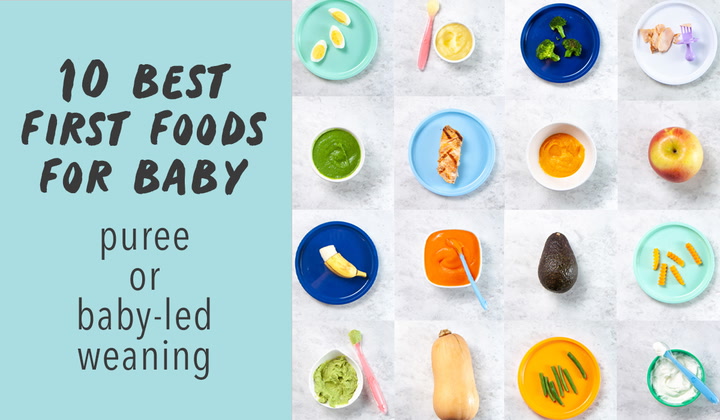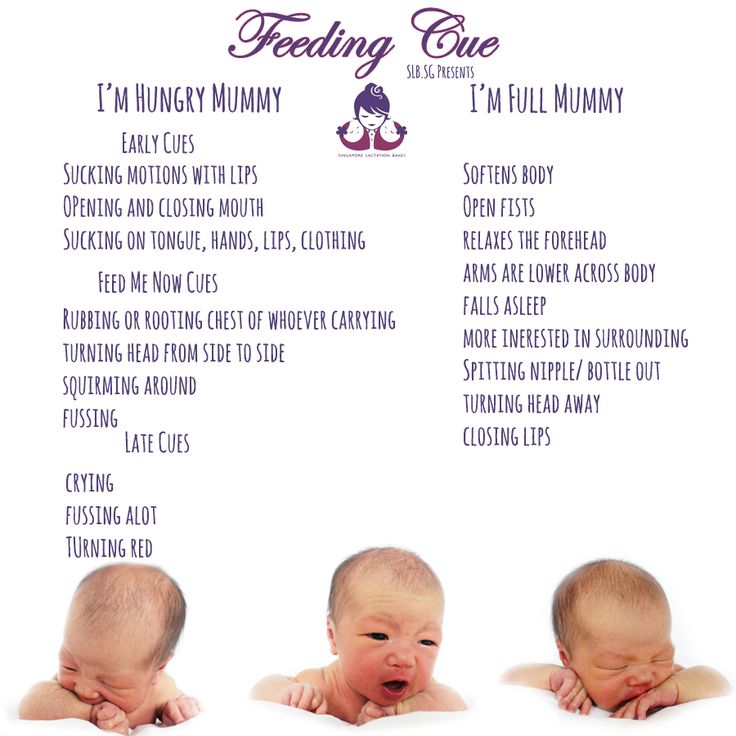Baby first solid food ideas
10 Baby Food Purees (Stage 1)
Everything you need to know about making stage 1 baby food, including 10 recipes for tasty purees that are perfect for introducing solids.
Introducing solids to your baby is such an exciting milestone but it can also be an overwhelming time with lots of questions. When is your baby ready for solids? Which foods should you start with? And how do you make homemade baby food?
I’m here to make sure you have all the information you need! Plus sharing 10 baby food purees to give you some ideas of where to start if you’ve decided to make your own baby food.
When To Start Solids
Most pediatricians recommend babies start solids between 4-6 months, but you know your baby best so trust your gut and do what feels right to you (with guidance from your pediatrician)!
I have a great guide for introducing solids to babies where I outline the basics and share my approach, but just to recap, here are some signs that your baby is ready to start enjoying solid food:
- Baby can hold their head up in an upright position without too much bobbing
- Baby can sit up with (or without) support
- Baby has lost the tongue thrust reflex
- Baby puts their hands or toys in their mouth
- Baby has shown interest in food such as leaning forward and opening their mouth or trying to grab food you’re eating
How to Introduce Solid Food to Baby
Once you’ve decided that your baby is ready to start solids, it’s go-time. There are different approaches to this including baby led weaning, where you skip purees all-together and let your baby feed themselves with finger foods from the start and traditional weaning, which starts with pureed (or blended) foods.
With Olivia I did a hybrid approach where the first few foods we introduced where purees and then we started with a few finger foods when she seemed ready. I go into more detail on this in my introducing solids post.
To be honest, if you’re planning to do baby led weaning this post probably won’t be that helpful because it’s focused on how to make a variety of single ingredient purees.
What is Stage 1 Baby Food?
If you decide to use purees, you’ll quickly notice that baby food is labeled by three stages. Here is a breakdown of what these different stages mean:
- Stage 1 (4-6 months) – single ingredient foods that are pureed into a very thin consistency with no chunkiness whatsoever that can be served with a spoon.

- Stage 2 (around 6-8 months) – slightly thicker consistency and typically includes food combinations and the addition of spices like cinnamon, nutmeg, turmeric, mint, basil, etc. See my stage 2 baby food combos.
- Stage 3 (around 9-12 months) – thick blended foods with chewable chunks or small cut up pieces of easily chewed food.
Best First Foods for Baby
Solid foods can be introduced in any order, but most pediatricians recommend starting with a single-ingredient food that is easy to digest like pureed sweet potato, carrot, banana and/or avocado. Other options include pureed meats, poultry, beans and iron-fortified baby cereals like rice cereal or oatmeal.
You just want to be sure the first few foods are pureed super smooth and almost a liquid consistency. You can easily thin purees with breastmilk or formula.
As baby gets more practice with eating you can reduce the amount of liquid and offer purees with a thicker texture.
Food Allergies and Known Allergens
When introducing foods it can be helpful to introduce only one food every three to five days so you can watch for any signs of allergic reactions. A reaction could show up almost immediately or a few days after so it’s recommend to introduce one food at a time when starting out so you can track what may be causing a reaction in your baby. Reactions include: hives or rashes, itching, shortness or breath or more serious reactions like vomiting or swelling of the lips and tongue.
It’s also helpful to be mindful about common allergens. Foods like diary, eggs, peanuts, tree nuts, wheat, soy and shellfish should be introduced gradually after less allergenic foods have been tolerated. The previous recommendation was to wait on these foods, but that as since changed and in fact, delaying the introduction of these foods may increase the risk of a child developing allergies.
One food that is off limits until a baby is at least 1 year old is honey because of the risk of infantile botulism.
How to Make Homemade Baby Food
We covered when and what foods to start with. Now lets talk how to make a basic baby food puree! Don’t fret, it’s super easy. Here’s the basic process:
- Prep: you’ll want to start by ensuring your fruit or vegetable of choice is thoroughly cleaned. Even if you’re using organic fruits and vegetables, you’ll want to washed and dry your produce! Once the produce is clean, you’re ready to peel and chop into chunks. You can skip this step for some fruits or veggies.
- Cook: some foods like banana and avocado don’t need to be cooked, but many do. For cooking, you can steam, boil or roast. I recommend using a fork to test that they’re tender and soft.
- Blend: place cooked food into a blender or food processor and blend until smooth (or the consistency you desire), adding liquid (breast milk, formula or water) as needed.
That’s it! You’ve just made a homemade baby food puree!
Best Tools For Making Homemade Baby Food
You really don’t need any fancy kitchen appliances, but there are a few tools that will come in handy when making homemade baby food.
- Steamer basket – Steaming is one the easiest ways to cook foods for making purees and having a steamer basket is key. I have a really basic steamer basket that fits in most pots, but I also use the steamer basket that comes with my Always Pan.
- Blender – I’ve been using my Vitamix blender and love how smooth it makes the purees. You can also use a food processor or an immersion blender.
- Silicone ice cube trays – In the beginning I really liked to make large batches of pureed food and pour it into a silicone ice cube tray with a lid to freeze for later. It was perfect when babies aren’t eating big portions because each cube is about 1-2 ounces.
- Freezer bags – Once you have frozen cubes of puree you can transfer them to a freezer-safe bag. I love reusable Stasher bags for this.
- Storage containers – As soon as you start making homemade baby food you realize that you need lots of little containers.
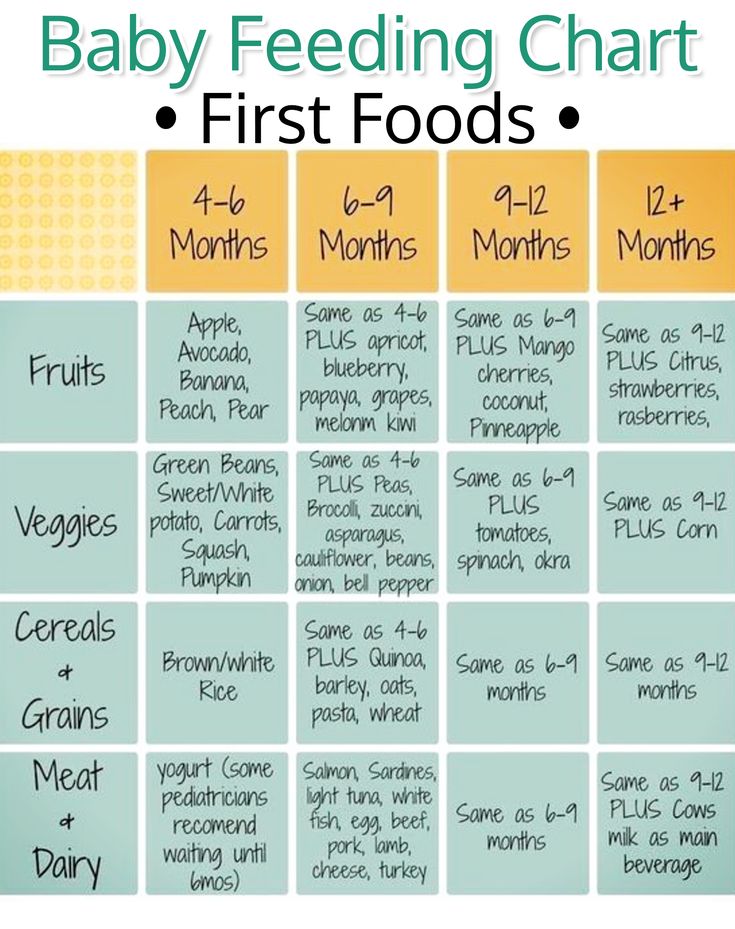 A friend loaned me a bunch of plastic storage containers for keeping homemade baby food and I also invested in these glass containers that are freezer safe.
A friend loaned me a bunch of plastic storage containers for keeping homemade baby food and I also invested in these glass containers that are freezer safe. - Permanent markers – When storing and freezing baby food you’ll want to label everything with the name of the food and the date.
- Baby food maker – if you’re looking for an all-in-one solution that steams food and blends it there are some cool gadgets (like the BEABA Babycook) that make homemade baby food a breeze!
10 Stage One Baby Food Purees
Ready to get started making some stage 1 baby food purees? Here are 10 easy recipes to get you started. These are the purees I used in the early days with Olivia. She loved all of these, but there are a ton of other purees you can try including pear puree, apple puree (aka applesauce), bean purees (like chickpea or lentil puree) and even chicken puree.
Sweet Potato
Sweet potatoes are a powerhouse vegetable! They’re packed with fiber, vitamins, minerals and antioxidants and babies love their sweet flavor.
Sweet Potato Puree
3.88 from 8 votes
Sweet potato puree is so easy to make. Just bake your sweet potatoes, peel and blend until smooth! It's a great first food for babies, but can also be used in baking recipes, mixed into oatmeal, added to smoothies or served as a side dish.
Get Recipe
Carrot
Carrots are low on the allergy scale and easily digested by a tiny tummy. They are high in beta-carotene, an antioxidant that converts to vitamin A in the body, which is crucial for eye health and overall immune function.
Carrot Puree
4 from 39 votes
How to make carrot baby food by cooking and blending carrots into a smooth and creamy puree. Carrot puree make a great stage 1 starter food for babies.
Get Recipe
Avocado
Avocados are high in heart-healthy fats as well as fiber, vitamins, minerals and antioxidants! They’re incredibly nutritious and super easy to prepare.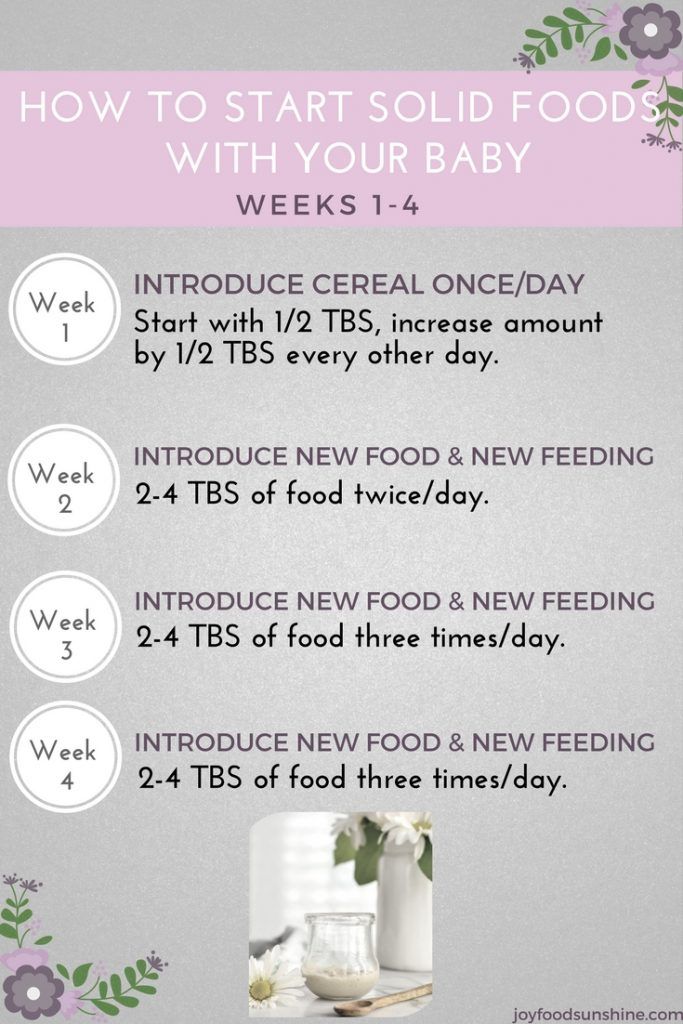
Avocado Puree
5 from 3 votes
Avocado is great first food for babies. It contains healthy fats, it’s easy to blend and it’s delicious. Make it in your food processor or blender or simply mash!
Get Recipe
Banana
A great first food to introduce to babies, bananas are naturally soft and mushy, easy to digest and loaded with vitamins and minerals. The best part? You don’t need to cook them!
Banana Puree
5 from 2 votes
Fresh banana puree is a great first food and baby will love it because it tastes sweet! Easily make it by mashing or blending ripe bananas.
Get Recipe
Peas
Peas are naturally sweet and pack a punch with nutrition, containing a variety of vitamins, minerals and antioxidants. They are also high in protein, with 4 grams per half-cup serving. Fun fact, peas are actually a legume!
Pea Puree
5 from 5 votes
Pea puree is a great first food when introducing solids to babies and all you need is a bag of frozen peas and a blender or food processor!
Get Recipe
Butternut Squash
Technically a fruit, butternut squash is packed with fiber, vitamins and minerals.
Butternut Squash Puree
Make butternut squash puree at home with this simple recipe! Just scoop the seeds, roast, blend and use in recipes that call for butternut squash puree. It's also a great first food for babies!
Get Recipe
Peach
Peaches are naturally sweet and perfect for introducing baby to solid foods. They are rich in many vitamins, minerals and antioxidants.
Peach Puree
5 from 4 votes
Peach puree is so easy to make using fresh peaches! It's a great first food for babies, but can also be used as a topping or mix-in for breakfast, dessert and drink recipes.
Get Recipe
Mango
Rich in vitamins, minerals and antioxidants, mango is especially high in vitamins A and C. They also contain a group of digestive enzymes called amylases which help little tummies just starting with solid foods.
Mango Puree
5 from 3 votes
How to make a delicious mango puree out of fresh (or frozen) mango. It's perfect for serving to baby or to use in recipes.
It's perfect for serving to baby or to use in recipes.
Get Recipe
Blueberry
Small but mighty! Blueberries are known as a superfood. Superfoods are usually plant-based and rich in nutrients that are beneficial to your health such as vitamins, minerals, healthy fats and fiber.
Blueberry Puree
5 from 1 vote
Blueberry puree is full of antioxidants and vitamins and makes for a quick and easy first food for baby! It can also be used as a topping or mix-in for breakfast, dessert and drink recipes.
Get Recipe
Strawberry
Strawberries pack quite a health punch! They are low calorie, taste delicious and are a great source of vitamins, minerals and plant compounds.
Strawberry Puree
5 from 1 vote
Strawberry puree is easy to make and naturally sweet with no added sugar! Use it in baked goods, drinks or as baby food.
Get Recipe
How to Store Purees
Freshly pureed baby food should be stored in the fridge and used within 3-4 days. For longer storage, I recommend freezing purees in an airtight container. I like using silicone ice cube tray or freezer safe jars because they make it easier to thaw smaller amounts for serving to babies.
For longer storage, I recommend freezing purees in an airtight container. I like using silicone ice cube tray or freezer safe jars because they make it easier to thaw smaller amounts for serving to babies.
How to Thaw Frozen Puree
I recommend thawing frozen purees in the fridge the night before you want to use them. In a pinch, you can also thaw it quickly with a warm water bath. It thaws quickly if you’re defrosting a small amount to serve to a baby.
FAQ
Can I store homemade baby food purees?
Yes! Making large batches of purees and storing them in the refrigerator or freezer makes feeding baby homemade purees a breeze.
Can you freeze homemade purees?
Freezing baby food that has been made with frozen fruit or vegetables is fine, as long as you have cooked the frozen foods first. Do not refreeze foods that have thawed without cooking. I recommend labeling baby food with the ingredient and date before you place them in the freezer.
Can you freeze baby food made with breast milk or formula?
If you are freezing baby food that has been mixed with fresh breast milk you’re fine! However, you should not freeze baby food that has been mixed with previously frozen breast milk. Once frozen breast milk has been thawed, it should never be re-frozen.
If you are using formula, it should be okay to freeze baby food that has been mixed with it. Most formula companies don’t recommend freezing formula, but you’re using such a small amount.
You can also freeze the baby food purees without adding any liquid. You can then thaw the baby food puree in the fridge overnight and then thin the food to the desired consistency with breast milk or formula right before serving.
This post about freezing baby food has a ton of great insight and tips.
Should I use organic fruits and vegetables?
I recommend using organic produce when possible, though I realize this isn’t always in the budget. Either way thoroughly rinsing your fruits and vegetables is an important step whether they’re organic or not.
Either way thoroughly rinsing your fruits and vegetables is an important step whether they’re organic or not.
This list of the dirty dozen fruits and vegetables from the EWG is a good guide if you can only budget for some but not all organic produce.
Is it safe to thin baby food with cow’s milk?
From a nutritional point of view, most doctors recommend waiting to introduce babies to cow’s milk until one year of age. If you need to thin your puree you can use breast milk, formula or plain water.
What is the difference between stage 1 and stage 2 baby food?
Stage 1 purees are very thin with no chunkiness and are single ingredients. Stage 2 baby foods can be more elaborate with food combinations as well as chunkier textures.
More Recipes for Resources
- Baby Pancakes
- How to Make Oatmeal For Babies
- Baby (+ Toddler) French Toast
- Applesauce
- Baby Yogurt Melts
- 6 Baby Food Combinations (Stage 2)
Be sure to check out all of the baby food recipes here on EBF.
10 Stage One Baby Food Purees
5 from 5 votes
Everything you need to know about making stage 1 baby food, including 10 recipes for tasty purees that are perfect for introducing solids.
Print Recipe Pin Recipe
Prep Time 10 minutes
Cook Time 20 minutes
Total Time 30 minutes
Servings 6
Sweet Potato
- 2 cups steamed and peeled sweet potatoes
- water, breast milk or formula to thin
Carrot
- 1 lb steamed and peeled carrots
- water, breast milk or formula to thin
Avocado
- 1 avocado
- water, breast milk or formula to thin
Banana
- 1 banana
- water, breast milk or formula to thin
Pea
- 2 cups cooked peas
- water, breast milk or formula to thin
Butternut Squash
- 2 cups steamed and peeled butternut squash
- water, breast milk or formula to thin
Peach
- 3 ripe peaches
- water, breast milk or formula to thin
Mango
- 2 ripe mangoes
- water, breast milk or formula to thin
Blueberry
- 2 cups blueberries
- ½ cup water
Strawberry
- 2 cups strawberries
- water, breast milk or formula to thin
Add veggies or fruit into a high powered blender or a food processor.
 Blend and add liquid until you reach the consistency you desire. You can make the purees smooth and thin for young babies or thicker and chunkier for older babies.
Blend and add liquid until you reach the consistency you desire. You can make the purees smooth and thin for young babies or thicker and chunkier for older babies.
blender
food processor
Serving: 1sweet potato Calories: 75kcal Carbohydrates: 17g Protein: 1g Sodium: 48mg Potassium: 292mg Fiber: 3g Sugar: 4g
DID YOU MAKE THIS RECIPE?
Please leave a comment and star rating on this post and share on social media using the hashtag #eatingbirdfood. I love seeing your recipe shares!Best Early Finger Foods for Baby (With Tips, Visuals, and Recipes)
Use this list of safe, nutritious, and easy to eat finger foods for baby to help you know exactly what (and how) to offer at meals and snacks. Plus, find the best first finger foods, troubleshooting tips, and visuals of foods broken down by food group to keep things easy!
Finger Foods for Baby
After baby starts solids and is ready to move onto finger foods, you may feel a little confused by exactly what to serve and how to serve it. Which is totally normal because it can be scary to let baby feed themselves this way and we may not have any experience doing this—or we may have totally forgotten from our last kiddo!
Which is totally normal because it can be scary to let baby feed themselves this way and we may not have any experience doing this—or we may have totally forgotten from our last kiddo!
This list of finger foods for baby will cover some great first finger foods to start with, then set you up with plenty of healthy options from each food group.
TIP: Find more info on starting solids here and the best foods to start with if doing baby led weaning or purees with baby.
Healthy Baby Food
I love sharing these ideas for baby food since they are easy to prepare and serve and because I know how hard it can be to continue to come up with flavorful and healthy meals and snacks for our little ones. Let me tell you, I’m on my third kiddo and it can be such a challenge to feed him during the chaos of parenting the rest of my crew! These foods are wholesome and nutritious—perfect for your baby.
TIP: I’m a big fan of SpoonfulONE, a company that offers the most complete way to introduce food allergens to our kids. They make mix-ins, puffs, and crackers that are yummy and easy for babies and toddlers to eat. Learn more about their pediatrician-approved baby foods here. (sponsored link)
They make mix-ins, puffs, and crackers that are yummy and easy for babies and toddlers to eat. Learn more about their pediatrician-approved baby foods here. (sponsored link)
Best First Finger Foods
When baby is around 9 months, you’ll notice that they’re able to pick up smaller pieces of food with two fingers. This is known as the “pincer grasp” and is a sign that they’re ready to start finger foods. To be clear, when I say “finger foods” I mean small pieces of food that a baby (or toddler) can feed themselves.
Here are some of my favorite ones to start with that are all super soft, safe to eat, and easy to pick up.
- Scrambled egg, broken up into small pieces
- Roasted sweet potato mashed and broken up into small pieces
- Fresh raspberries, broken up into smaller pieces
- Oatmeal, cooked according to package directions and allowed to cool
- Tofu, diced and sauteed lightly or steamed
- Ground beef, chicken, or turkey, broken up into small pieces or lightly mashed meatballs
- Shredded cheese or crumbled goat cheese
- Mashed sweet potato, in little pieces
- Peanut butter puffs
TIP: You can serve the tofu, ground meat, or meatballs in veggie puree from a pouch or a simple marinara sauce for extra moisture and flavor.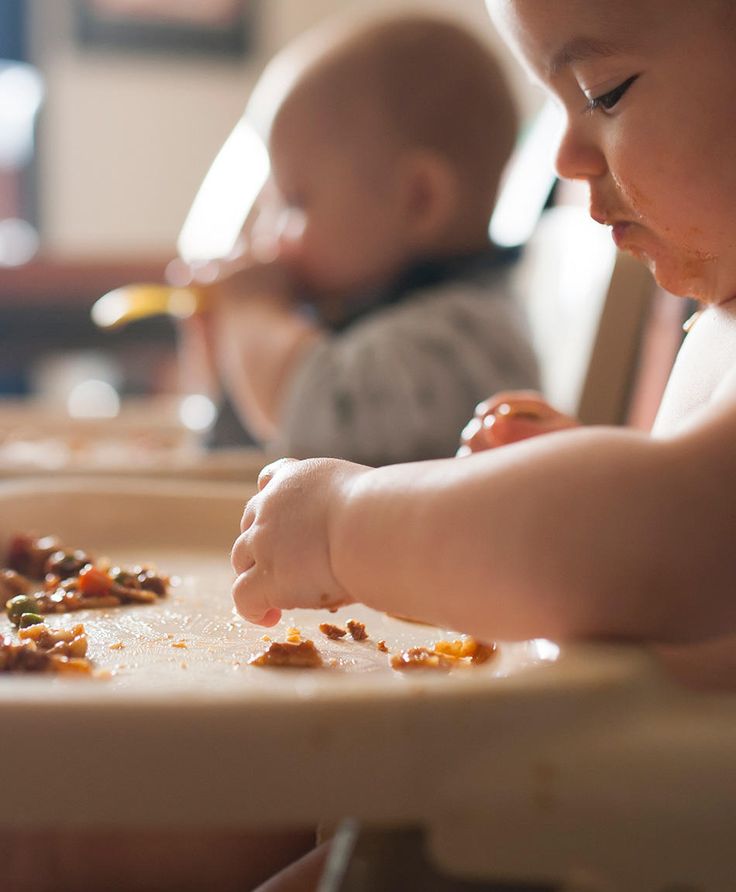 Learn more about how and why to introduce peanut butter.
Learn more about how and why to introduce peanut butter.
Finger Foods for Baby: Fruits and Veggies
Some of my favorite early fruits and veggies to serve babies are:
- Mashed roasted sweet potato, broken up into small pieces
- Warmed frozen peas, slightly mashed if desired
- Roasted Zucchini
- Diced Roasted Sweet Potato or Butternut Squash
- Fresh blueberries, cut in half or quarters
- Fresh raspberries, broken into small pieces
- Banana, broken into small segments (they are less slippery this way versus slicing them)
- Avocado, diced and mashed slightly (be sure it’s ripe and very soft)
TIP: A good rule of thumb is to serve pieces of food that are about the size of a pea to start and soft enough that they are easy to squish between your fingers. This will be easy for baby to pick up and eat and will also reduce chances of choking.
Finger Food Ideas: Carbohydrates
Offering complex carbohydrates can provide fiber, a variety of textures, B vitamins, and more. Try these with your baby.
Try these with your baby.
- Spinach pancakes (moisten with applesauce or plain yogurt if needed; this recipe is particularly moist and great for babies)
- Oatmeal, cooked according to package directions and allowed to cool
- Baby Puffs
- Peanut Butter Puffs
- Rice (it’s easiest if it’s in little clumps so baby can pick it up; this Coconut Rice or this Cheesy Rice are both good options)
- Baby Banana Muffin
- O cereal (soften in nondairy unsweetened milk or yogurt as needed)
- Baked Oatmeal, diced
Finger Food Ideas: Proteins
Offering proteins will continue to expose baby to a range of nutrients. These are my go-tos for babies newer to finger foods—and toddlers too.
- Shredded cheese (thicker cuts are a little easier to pick up)
- Tofu, diced and sauteed lightly or steamed
- Flaked cooked wild salmon
- Lightly mashed meatballs
- Shredded chicken, cut up finely (we love this Butter Chicken to share with baby)
- Ground beef, turkey, or chicken, broken into smaller pieces
- Lightly mashed beans
- Scrambled eggs, broken up into small pieces
- Diced egg muffins
I’d love to hear any questions you may have, or if you have foods that your babies enjoy that I didn’t include here.
 Chime in below in the comments!
Chime in below in the comments!Prep Time 5 minutes
Cook Time 5 minutes
Total Time 10 minutes
Author Amy Palanjian
Cuisine American
Course Baby Food
Calories 124kcal
Servings 1
First Finger Foods (choose 1-3 per meal)
- ▢ 1 Scrambled egg (broken up into small pieces)
- ▢ 1/4 cup Roasted sweet potato, mashed and broken up into small pieces
- ▢ 1/4 cup Fresh raspberries (broken up into smaller pieces)
- ▢ 1/4 cup Oatmeal (cooked according to package directions and allowed to cool)
- ▢ 2 tbsp Tofu (diced and sauteed lightly or steamed)
- ▢ 2 tbsp ground beef, chicken, or turkey, broken up into small pieces or lightly mashed meatballs
- ▢ 2 tbsp shredded cheese or crumbled goat cheese
- ▢ 1/4 cup Mashed sweet potato (broken into little pieces)
- ▢ 1/4 cup Peanut butter puffs
Fruits and Veggies
- ▢ 1/4 cup mashed roasted sweet potato (broken up into small pieces)
- ▢ 1/4 cup warmed frozen peas
- ▢ 1/4 cup Roasted Zucchini
- ▢ 1/4 cup diced Roasted Sweet Potato or Butternut Squash
- ▢ 1/4 cup blueberries (cut in half or quarters)
- ▢ 1/4 cup raspberries (broken into small pieces)
- ▢ 1/4 cup banana slices (broken into small segments—they are less slippery this way versus slicing them)
- ▢ 2 tbsp avocado (diced and mashed slightly—be sure it's ripe and very soft)
Whole Grains and Carbohydrates
- ▢ 1 Spinach pancakes (moisten with applesauce or plain yogurt if needed; this recipe is particularly moist and great for babies)
- ▢ 1/4 cup Oatmeal (cooked according to package directions and allowed to cool)
- ▢ 1/4 cup Baby Puffs
- ▢ 1/4 cup Peanut Butter Puffs
- ▢ 1/4 cup fully cooked rice (it's easiest if it's in little clumps so baby can pick it up; this Coconut Rice or this Cheesy Rice are both good options)
- ▢ 1 Baby Banana Muffin
- ▢ 1/4 cup O cereal (soften in nondairy unsweetened milk or yogurt as needed)
- ▢ 1/4 cup Baked Oatmeal (diced or regular oatmeal broken into little pieces)
Dairy
- ▢ 2 tbsp Shredded cheese (such as mozzarella)
- ▢ 2 tbsp Tofu (diced and sauteed lightly or steamed)
- ▢ 2 tbsp flaked cooked wild salmon
- ▢ 1 lightly mashed meatballs
- ▢ 2 tbsp finely shredded chicken (we love this Butter Chicken to share with baby)
- ▢ 2 tbsp ground beef, turkey, or chicken (broken into smaller pieces)
- ▢ 2 tbsp lightly mashed beans
- ▢ 1 Scrambled egg (broken up into small pieces)
- ▢ 1 Diced Egg muffins
For each meal or snack, choose 2-3 foods from a mix of food groups.
 Aim to include some fat in most meals and protein in many too.
Aim to include some fat in most meals and protein in many too.Prepare the food, cutting into small pieces and/or mashing as needed to make the food easy to eat.
Start with small portions and allow more as baby indicates according to their hunger.
- Store leftovers in an airtight container for 3-5 days in the fridge.
- Many foods you cook for your family will work as baby finger foods—just be sure they are easy to squish between your fingers and the pieces are small and easy to chew.
- Babies very normally make a lot of faces when they eat, so don't assume they don't like something just because they scrunch their nose!
- Flavors and textures can take time to learn to eat, so continue offering foods in small portions even if baby hasn't liked them in the past—and make sure they taste good to you!
Calories: 124kcal, Carbohydrates: 14g, Protein: 7g, Fat: 4g, Saturated Fat: 1g, Polyunsaturated Fat: 1g, Monounsaturated Fat: 2g, Trans Fat: 1g, Cholesterol: 164mg, Sodium: 81mg, Potassium: 344mg, Fiber: 4g, Sugar: 5g, Vitamin A: 9857IU, Vitamin C: 18mg, Calcium: 51mg, Iron: 1mg
Tried this recipe?Rate in the comments and tag @yummytoddlerfood on IG!
at what age to introduce with breastfeeding and artificial feeding, how to cook at home
When to introduce the first complementary foods
Today there are no hard and fast rules and deadlines for the introduction of complementary foods.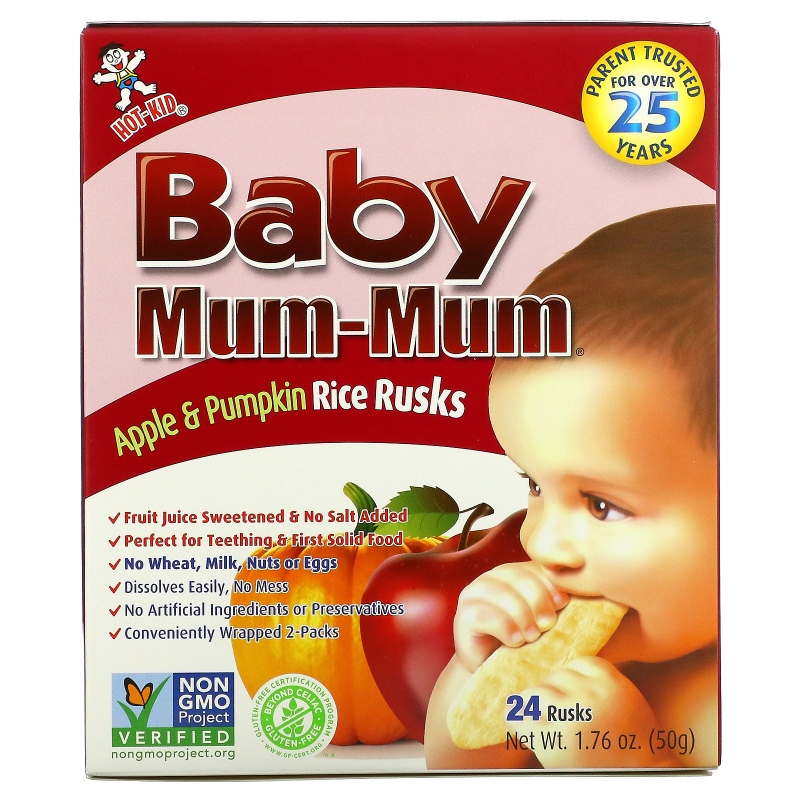 Parents should first of all focus on the signs of the child's readiness for complementary foods. Here is what pediatrician, candidate of medical sciences Anna Levadnaya advises to pay attention to , the author of a blog about pediatrics and not only on Instagram.
Parents should first of all focus on the signs of the child's readiness for complementary foods. Here is what pediatrician, candidate of medical sciences Anna Levadnaya advises to pay attention to , the author of a blog about pediatrics and not only on Instagram.
The child holds his head confidently.
- Can sit with support, meaning it can be placed in a high chair or placed on an adult's lap.
- The kid shows an active interest in food: he is interested in food, he watches what adults eat.
- Breastfeeding or formula feeding is well organized and does not cause any problems.
- The child can put his hand to his mouth, puts various objects in his mouth, such as toys. In this case, the baby chews or champs.
As a rule, all these signs appear in the period from 5.5 to 7.5 - 8 months, but most often around 6 months. All babies develop differently, and one baby may be ready to try his first puree or porridge as early as 5 months, and another at 6 or 7 months will refuse the new food you offer.
What complementary foods a child needs in the first months
Again, there are no strict recommendations and rules. On the contrary, many experts agree that it doesn’t matter which dish you start complementary foods with, the most important thing is to provide the right nutritional interest. In this case, the child will eat all the foods that you offer him.
In Russia, it is customary to focus on the following scheme for the introduction of complementary foods. The first to introduce cereals or vegetables, depending on the weight of the child. As a rule, vegetables are first, then cereals, then meat, then fruits, then cottage cheese. In some US states, for example, on the contrary, it is recommended to start complementary foods with meat. But the general message of the recommendations is to maximize the variety of tastes and textures in the first year of life. From vegetables in the first months, you can offer zucchini, cauliflower, broccoli, pumpkin, carrots, potatoes. Of the cereals, gluten-free are the first to be introduced: rice, buckwheat, corn. From fruits - apple, pear, banana, peach and others. From meat - it is better to start with a rabbit, turkey, chicken, veal.
— At the very beginning, complementary foods should be puree-like, says Anna Levadnaya. - It is better to give preference to monocomponent purees so that the baby learns to distinguish between different tastes. As you introduce vegetables and cereals, add butter and vegetable oils to them. If there are no problems with the introduction of complementary foods, it is recommended to use the maximum variety of food textures as early as possible. Starting from 7-8 months, the baby can and should be introduced to semi-solid foods. This is very important for the correct formation of food interest, and for the development of chewing skills, the correct functioning of the tongue, the development of speech, the “tweezer” grip, and the coordination of the work of hands, mouth and eyes. If you do not introduce semi-solid food in time, then there may be problems with the introduction of already solid food, and after a year the child will refuse it completely. Therefore, starting from 7-8 months, the baby can be offered mashed or pureed food, such as a banana. From 8-9months, give the so-called "finger" food: cut into pieces soft fruits and vegetables, such as boiled carrots, potatoes, and put in front of the baby. By one year, the child is ready to eat solid food from the common table.
This is very important for the correct formation of food interest, and for the development of chewing skills, the correct functioning of the tongue, the development of speech, the “tweezer” grip, and the coordination of the work of hands, mouth and eyes. If you do not introduce semi-solid food in time, then there may be problems with the introduction of already solid food, and after a year the child will refuse it completely. Therefore, starting from 7-8 months, the baby can be offered mashed or pureed food, such as a banana. From 8-9months, give the so-called "finger" food: cut into pieces soft fruits and vegetables, such as boiled carrots, potatoes, and put in front of the baby. By one year, the child is ready to eat solid food from the common table.
How to properly feed your baby
It used to be that complementary foods should be introduced very carefully and gradually, always in the morning, many parents still introduce each product over a week or two, very slowly increasing portions.
- These recommendations are relevant, perhaps, only for the very beginning of complementary foods, the first two or three weeks, - says Anna Levadnaya. - In general, in children without food allergies, the most rapid and varied expansion of the diet is recommended. That is, a new product can be safely introduced every 2-3 days. If you need to breed complementary foods, for example, baby cereals, then it is better to do this with breast milk or formula, and not with cow's. Whole milk is not recommended for children under one year of age.
Also with the introduction of complementary foods, offer your child water, either bottled for children or boiled. It is recommended to offer water from a cup so that the child learns to drink, and not from a drinking bowl, a bottle with a tube or a pacifier.
Photo: pexels.com, MART PRODUCTIONMonitor the child's well-being, in case of any changes that worry you, consult a doctor.
Complementary foods with natural and artificial feeding
Mothers often wonder if there are differences in the introduction of complementary foods with natural and artificial feeding. In both cases, the recommendations are the same: it is recommended to focus on food interest, signs of the child's readiness for the introduction of complementary foods. Usually, as we have already noted, the baby receives only breast milk or an adapted milk formula up to 6 months. With exclusive breastfeeding, it is not recommended to supplement the baby with water, especially in the first month, when lactation is established. Bottle-fed babies can be offered water.
In both cases, the recommendations are the same: it is recommended to focus on food interest, signs of the child's readiness for the introduction of complementary foods. Usually, as we have already noted, the baby receives only breast milk or an adapted milk formula up to 6 months. With exclusive breastfeeding, it is not recommended to supplement the baby with water, especially in the first month, when lactation is established. Bottle-fed babies can be offered water.
For both breastfeeding and artificial feeding, it is recommended to offer the baby a new food before feeding, and then supplement it with breast milk or formula.
— It is desirable to keep breast milk or formula in the diet of a child up to a year, — says Anna Levadnaya. - After a year, it is better to leave the bottle completely, gradually reducing the amount of the mixture. After a year, preferably closer to one and a half, cow's milk can be offered if the child is not allergic to its protein. Breastfeeding can be continued as long as it brings pleasure to mother and child.
How to prepare the first complementary foods
Give canned puree and baby cereals or cook it yourself? This question worries many mothers.
“In fact, there is no universal advice here,” says Anna Levadnaya. - Do what is comfortable and best for you. But when choosing food, remember that you must be confident in the products you buy. If you are not sure, buy canned purees, industrial baby cereals. The main advantage of any industrial baby food is that the products from which it is made are tested for the content of pesticides, heavy metals, nitrates and other harmful substances (labeled up to 3 years). If you're cooking yourself, cook with either seasonal fruits and vegetables or frozen ones. It is best to do it for a couple - this is how most vitamins and minerals are preserved. The advantage of homemade products is that we can provide the child with a different consistency, which is very important. But in any case, choose what is more convenient for you, more comfortable, including financially. The main principle is to provide the baby with a varied diet. Alternate between different foods.
The main principle is to provide the baby with a varied diet. Alternate between different foods.
If you decide to cook on your own, follow our tips on how to prepare puree and porridge for the first feeding.
Vegetable puree
Zucchini, broccoli, cauliflower, carrots, pumpkin are suitable for the first feeding. The vegetable should be fresh, without dark spots. We clean it from the peel, boil or steam it. Then we pass through a blender. The vegetable should be quite soft to get the most uniform consistency (if necessary, you can add a little boiled water). If it did not work out, then additionally the mass can be rubbed through a fine sieve.
Fruit puree
To prepare fruit puree for your baby, such as apple or pear puree, fruit must first be baked in the oven, then peeled and passed through a blender or sieve to obtain the most homogeneous consistency. Choose fresh, ripe, seasonal fruits.
Porridges
Soak cereals (for the first feeding, we remind you, this is rice, buckwheat, corn) for 4-5 hours in warm water. Then dry, for example, in a preheated oven. Next, grind the porridge in a coffee grinder into the consistency of flour and cook in water until cooked, this is about 5 minutes. For one tablespoon you need about 50-70 ml of water.
Then dry, for example, in a preheated oven. Next, grind the porridge in a coffee grinder into the consistency of flour and cook in water until cooked, this is about 5 minutes. For one tablespoon you need about 50-70 ml of water.
The main mistakes of parents
In fact, there is nothing complicated in the management of complementary foods. Use the guidelines, common sense, and have fun introducing your little one to new foods. With Anna Levadna, we have compiled a list of mistakes that parents often make when introducing complementary foods. Try to avoid them.
In a hurry
It often happens that a child refuses the first complementary foods. Most often, this suggests that the baby is simply not ready for it yet. And the parents, by hook or by crook, are trying to feed him mashed potatoes or porridge. Under no circumstances should you force-feed your baby. It is worth postponing the introduction of complementary foods for one to two weeks.
Give mashed food from a bottle
Do not do this because the child must learn to eat liquid and solid food separately.
Add salt or sugar
These components are not recommended to be introduced into complementary foods for a child under one year old, sugar is better up to three years old.
Only the bottle is used too long
For example, in addition to formula, if the child is on IV, they give water, compote and other drinks from the bottle. The danger is that long-term use of the bottle can reduce the child's desire to eat complementary foods and malocclusion, as well as lead to speech delay and swallowing problems. From 6-8 months, offer your baby to drink from a cup.
The child is not allowed to play with food
But it is freedom in dealing with food, the desire to take a spoon, move it around the plate and on the table, touch the food, knead it, and so on - the key to a successful introduction of complementary foods.
Baby's first complementary foods at 4-6 months - where to start with porridge or vegetable puree? Principles, schemes for the introduction of complementary foods
At what age and with what to start complementary foods? What do you think? At 4 months, at 5, 6 months later? And where to start, what to give preference to: cereals or vegetable puree? Or maybe first give tasty and healthy fruits?
We have already made a whole series of video lectures on complementary foods for children, by months and products, but we are faced with the fact that many parents ask what is the best way to start complementary foods and at what age it is advisable to introduce it.
Parents, oddly enough, have especially many questions and uncertainties, children who are breastfed . You quite often confuse the two concepts until what age it is advisable to breastfeed and at what age it is worth introducing complementary foods.
Valid according to all recommendations, breastfeeding is necessary for a baby at least up to 6 months , and if possible longer. But this does not mean at all that a child at 5 or 6 months does not need complementary foods that will not allow the development of deficient conditions in a child, for example iron deficiency . Modern principles of introducing complementary foods to children are a kind of fusion of practical experience and the latest scientific developments. They are based on the recommendations of the European Association of Pediatric Gastroenterologists, Hepatologists and Nutritionists " ESPGHAN " 2017, the American Academy of Pediatrics " AAP " and national recommendations of relevant ministries and associations.
According to European recommendations, which also apply to our countries, the first complementary foods should be started:
That is optimal, Complementary foods should be introduced within 5-6 months life.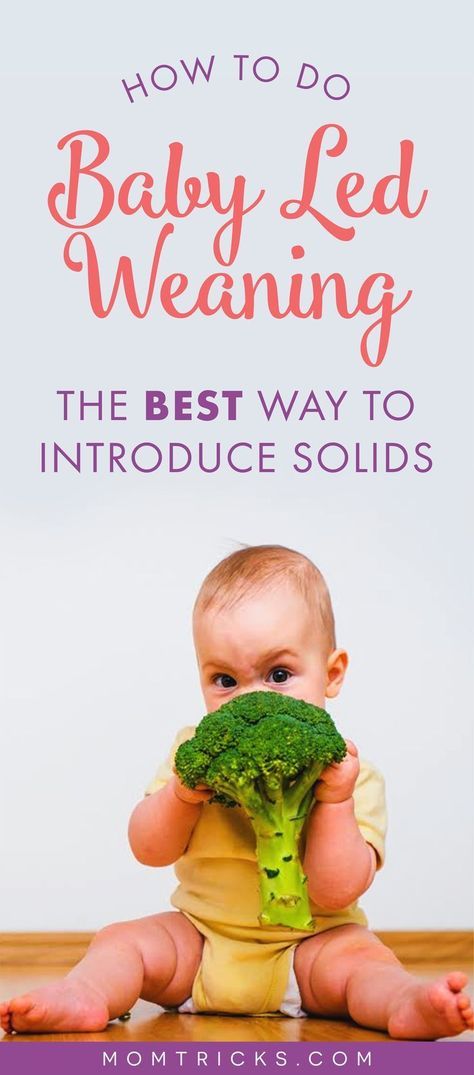 There is no specific, clear, unambiguous age at which complementary foods should be introduced. You have a certain corridor - 2 months and you and your pediatrician must decide when to start complementary foods, focusing on how the child develops, how he gains weight, whether he has signs of readiness for complementary foods, which we have already talked about in previous our videos, what hemoglobin is, and even if you have enough milk if the baby is breastfed. At the same time, there is a kind of paradoxical situation, despite the fact that 9 breast milk is the best food for babies including iron, and in breast milk for a child aged 5-6 months, it may already be a little lacking.
There is no specific, clear, unambiguous age at which complementary foods should be introduced. You have a certain corridor - 2 months and you and your pediatrician must decide when to start complementary foods, focusing on how the child develops, how he gains weight, whether he has signs of readiness for complementary foods, which we have already talked about in previous our videos, what hemoglobin is, and even if you have enough milk if the baby is breastfed. At the same time, there is a kind of paradoxical situation, despite the fact that 9 breast milk is the best food for babies including iron, and in breast milk for a child aged 5-6 months, it may already be a little lacking.
At the same time, there are no separate recommendations for introduction of complementary foods for breastfed or formula-fed children, approaches in these cases are the same . Thus, I hope that we have understood when to introduce complementary foods to healthy full-term babies who do not have serious diseases. Timely introduction of complementary foods contributes to the optimal development of all systems and organs of the child, physical parameters, psychomotor development, and the activity of the nervous system. The period of introduction of complementary foods, on the one hand, is very important for the growth and development of the child, on the other hand, it is a kind of stage in the transition of the child from breastfeeding to food from the general table.
Timely introduction of complementary foods contributes to the optimal development of all systems and organs of the child, physical parameters, psychomotor development, and the activity of the nervous system. The period of introduction of complementary foods, on the one hand, is very important for the growth and development of the child, on the other hand, it is a kind of stage in the transition of the child from breastfeeding to food from the general table.
First complementary foods - where to start?
- If the child develops normally , has a good or even excessive weight gain, it is better to start with one-component vegetable puree .
- If the child is not gaining weight well enough, then gluten-free cereals are better: rice, buckwheat, corn
- Not recommended
The child is very smart and if he tries sweet fruit puree, he can refuse relatively tasteless vegetable foods and cereals for a long time, and you may have difficulty introducing these healthy dishes.
Which is better factory-made or homemade?
Quite often we are asked what is better to give: ready-made vegetable purees and cereals, that is, factory-made, or making them yourself at home. It's up to you to decide. I often recommend industrial products from European manufacturers to my patients, because I am confident in the very strict quality control of baby food in Europe, but if you are confident in the products and water that you have at home, you can do everything yourself.
What is useful in vegetable supplements and what is the best way to prepare it?
Vegetable puree - for the first feeding can be prepared from cauliflower, zucchini, pumpkin, broccoli and vitamins and microelements! Fiber helps move food through the digestive tract and promote beneficial microflora in the gut. Pectins absorb and remove toxins from the baby's body. Vegetables have a positive effect on the acid-base balance of the body, creating conditions for the proper functioning of all organs and systems.
Cauliflower - is a source of fiber, protein, minerals and various vitamins, it is rich in magnesium, sodium, potassium, phosphorus, calcium, iron.
Iron it contains twice as much as green peas, peppers and lettuce. Cauliflower protein is easily digestible and its content is quite significant. The cauliflower protein contains methionine . It is one of the essential amino acids that cannot be synthesized by the human body. Other essential amino acids are also present in a small amount: arginine, tryptophan.
Zucchini - rich in vitamins and microelements. It contains potassium, magnesium, phosphorus, calcium, vitamins, folic acid. The latter plays an important role in the processes of hematopoiesis. Zucchini is rich in trace elements that are necessary for the formation of nervous tissue, normal metabolism, and the formation of hemoglobin.
Broccoli is a very healthy vegetable that is a type of cauliflower.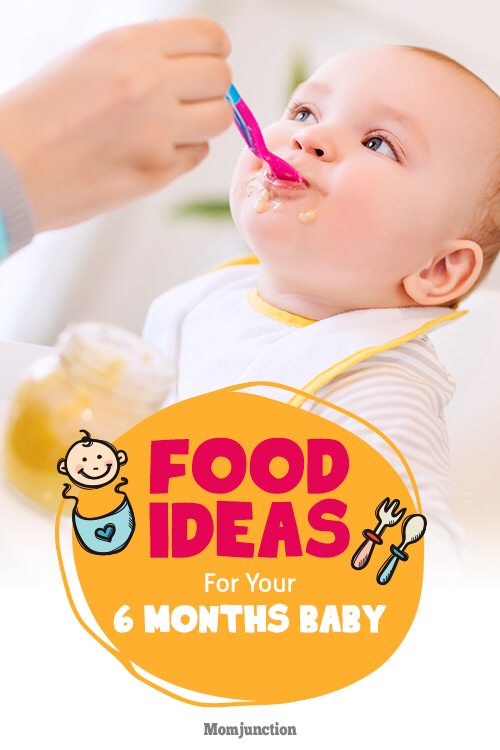 Pleasant soft taste and good digestibility of the product, the unique composition has a positive effect on the health of children. Eat unopened cabbage inflorescences.
Pleasant soft taste and good digestibility of the product, the unique composition has a positive effect on the health of children. Eat unopened cabbage inflorescences.
This is also a low-allergenic vegetable rich in protein, fiber, vitamins, calcium, iron, trace elements and even phytoncides. The content of calcium and magnesium in broccoli is enough to balance the functioning of the nervous system, ensure the normal regulation of the child's sleep cycle, good resistance to stress. When eating this vegetable, the child becomes calmer, less excited and naughty. In addition, broccoli is the leader in content choline and methionine that the child needs.
Pumpkin - the largest vegetable on Earth. It is one of the ten most useful vegetables in the diet of children, contains a large amount of healthy proteins, fiber and vitamins, iron, potassium, magnesium and trace elements, which are indispensable for children's nutrition, as they strengthen the immune system and help fight inflammation, have a positive effect on the nervous system .
Vitamins and microelements contained in pumpkin help the child grow, provide healthy sleep, are responsible for the condition of the skin and eyes, improve metabolic processes, and accelerate the removal of harmful substances from the child's body. Due to its beneficial qualities, pumpkin can be one of the first types of complementary foods for a baby. All vegetable purees have a specific vegetable smell, this is absolutely normal.
Scheme for the introduction of vegetables in baby food
You need to introduce vegetables into the child's menu gradually. Each new vegetable should be started as a single-component puree in the amount of ½ teaspoon , preferably at breakfast, so you can track the manifestations of a food allergy or intolerance reaction to the product. If all is well, then the next day offer him a teaspoon .
So, gradually, you need to bring the portion to the age norm. Serving of vegetable puree per day for a child 6 months old - is about 100 grams, at this age you can start adding vegetable oil to vegetable puree and gradually increase to 1 teaspoon ), the rest of the portion is replenished with breast milk or formula. A serving of vegetable puree is 200 grams per year. The next vegetable product can be introduced no earlier than 4-5 days later, when the child gets used to the one he is already eating. In the future, you can make mashed potatoes from several vegetables. But don't be too hasty. If the child has a rash on the skin, diarrhea or constipation, then you need to temporarily remove the product from the diet, and after a while try again. If an undesirable reaction occurs again, it is better to exclude such a product from the child's diet for 6 months and consult a pediatrician.
Serving of vegetable puree per day for a child 6 months old - is about 100 grams, at this age you can start adding vegetable oil to vegetable puree and gradually increase to 1 teaspoon ), the rest of the portion is replenished with breast milk or formula. A serving of vegetable puree is 200 grams per year. The next vegetable product can be introduced no earlier than 4-5 days later, when the child gets used to the one he is already eating. In the future, you can make mashed potatoes from several vegetables. But don't be too hasty. If the child has a rash on the skin, diarrhea or constipation, then you need to temporarily remove the product from the diet, and after a while try again. If an undesirable reaction occurs again, it is better to exclude such a product from the child's diet for 6 months and consult a pediatrician.
If the child did not like the dish, for example, did not like broccoli, do not refuse what was planned and continue to offer it in small quantities - 1-2 spoons a day, you can even not just once, but 2-3 times before meals, and after 7 - 10, and sometimes 15 days, the baby will get used to the new taste.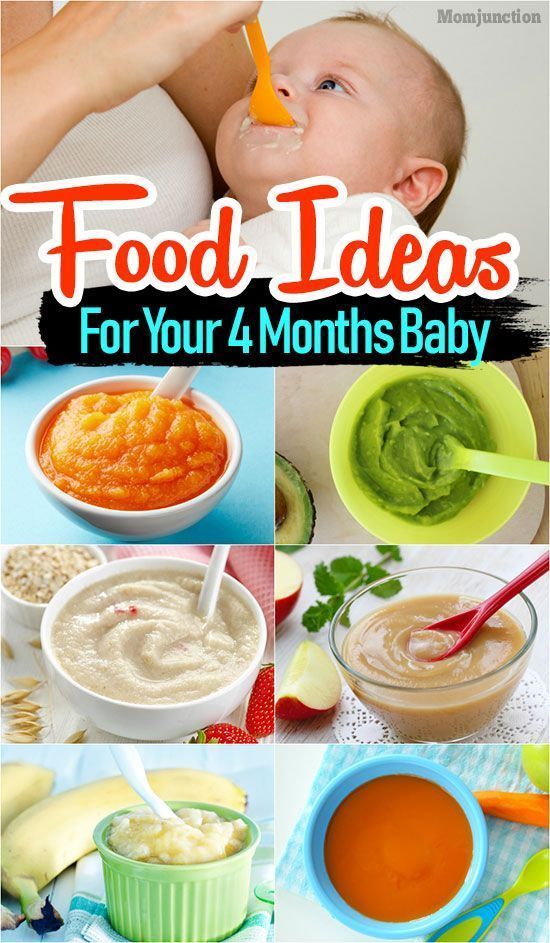
This will diversify the diet, help the child form the right taste habits. Porridges, as a rule, are the second complementary food after vegetable puree.
How and when to introduce porridge as the first complementary food?
If your child is not gaining weight very well, then complementary foods can be started with the introduction of cereals. It is important to start by choosing one-component, low-allergenic cereals , which do not contain gluten: these are buckwheat, rice, corn porridges .
gluten-containing cereals include: wheat, oats, rye, barley, millet.
According to modern data , the period of introduction of gluten into the child's diet is not of fundamental importance, but the latest recommendations draw attention to the fact that the amount of gluten in the diet of a baby up to a year old should not be large. Therefore, semolina and oatmeal porridge is better to add to other porridge in a limited amount , and not to give a whole separate portion of such porridge. If your child hasn't tried porridge yet, start with a dairy-free, gluten-free, one-ingredient buckwheat or rice porridge. Please note that completely eliminating cereals containing gluten from the child's diet is also a bad idea, the child should familiarize himself with such cereals before 8 months of age.
Therefore, semolina and oatmeal porridge is better to add to other porridge in a limited amount , and not to give a whole separate portion of such porridge. If your child hasn't tried porridge yet, start with a dairy-free, gluten-free, one-ingredient buckwheat or rice porridge. Please note that completely eliminating cereals containing gluten from the child's diet is also a bad idea, the child should familiarize himself with such cereals before 8 months of age.
Rice - very useful for growing baby's body. It has a low content of vegetable proteins, so it is easily digestible and is especially useful for children with loose stools . Rice has a high nutritional value and protects the delicate intestines of the baby to a certain extent thanks to the enveloping effect . This is a hearty and nutritious dish with a good content of carbohydrates and proteins, potassium and magnesium, calcium and phosphorus, beneficial amino acids and vitamins. It covers energy costs, energizes and gives strength. But rice is not recommended for overweight children and those who suffer from severe constipation.
It covers energy costs, energizes and gives strength. But rice is not recommended for overweight children and those who suffer from severe constipation.
Gluten-free buckwheat porridge - very nutritious and rich in iron, fiber, rich in various vitamins and microelements. This is a very good option for to introduce a child to adult food . All porridges can be prepared with water, breast milk, milk formula, which your child is used to. It is not recommended to give ordinary cow's milk to a child under one year old and use it to make cereals. No need to add salt and sugar.
If a child already eats porridge from 5 months - then at 6 months you can offer a more complex porridge, for example: rice porridge with apricot or raspberries, rice porridge with banana
is very successful
combination both in taste and properties) or even more complex porridge - corn-rice with banana .
Subsequently, apple, banana, pear, plum and prunes, apricot and dried apricots, broccoli, carrots, berries can be added to the porridge, provided that the child is not allergic to them.
Rules for the introduction of cereals as complementary foods for the baby
The same as for vegetable puree. To make it easier for the child to get used to the new product and its consistency, first prepare 5% porridge: 5 g of cereal per 100 g of water if you make it yourself. Porridge is usually cooked with water, but can be made with breast milk, infant formula. First, give the baby one teaspoon of porridge, then during 7-10 days bring the volume of porridge of the same percentage to the full volume of feeding, for example 150 g.
there are no skin rashes, the child has a normal stool - they switch to the gradual introduction of porridge of the same cereal, but already 10% concentration: 10 g of cereal per 100 g of water . Complete introduction of 10% porridge to the baby is also carried out for 7-8 days . The third week falls on the complete addiction of the child to a new dish. Only after that you can introduce a new cereal in the form of 10% porridge or the next complementary foods. Porridge should be given from a spoon, preferably in the morning, for breakfast . After porridge, at the stage of its introduction, the child should be offered breast or milk formula.
Complete introduction of 10% porridge to the baby is also carried out for 7-8 days . The third week falls on the complete addiction of the child to a new dish. Only after that you can introduce a new cereal in the form of 10% porridge or the next complementary foods. Porridge should be given from a spoon, preferably in the morning, for breakfast . After porridge, at the stage of its introduction, the child should be offered breast or milk formula.
When bottle-fed - the volume of the mixture after a portion of porridge should be such that together with porridge it is 200 ml for five feedings. In the future, the volume of a serving of porridge gradually increases, amounting to 160-170 ml at 7-8 months, 170-180 ml at 8-9 months, and up to 200 ml after 9 months (there is a complete replacement of one feeding of the child with complementary foods.
Cereal schedule
- day - 1 teaspoon 5 g
- day - 2 teaspoons 10 g
- day - 3 teaspoons 15 g
- day - 4 teaspoons 20 g
- day - 50 ml 50 g
- day - 100 ml 100 g
- day - 150 ml 150 g
General rules for the introduction of first complementary foods
Concluding our meeting, I would like to dwell on the general rules for the introduction of complementary foods to children in the first year of life, 10 tips from the professor:
- It is better to introduce the first complementary foods in the morning 9-11 am
- Do not add sugar or salt .

- When the child is calm and not tired.
- Start with 0.5-2 teaspoons . If the child refuses, do not insist.
- If there is no rash, skin changes, stool changes, double the dose the next day. Gradually, in 7-10 days bring the first complementary foods of the child to the age norm : 100-200 g
- If there is an allergic reaction refuse for 3 days
- Each subsequent new complementary food must be one-piece
- A dish of mixed foods give when the child has already become familiar with all foods separately.
- It is not advisable to introduce new products 3 days before and after vaccinations.
- Start feeding your baby at when you start feeding.
